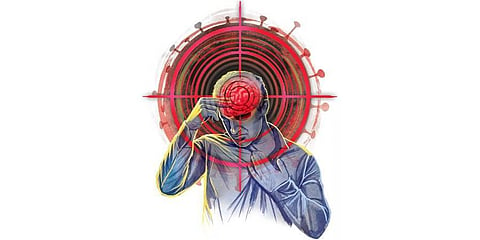

KOCHI: Stroke is a common cause of serious long-term disability and the second leading cause of death in the world. It is estimated that 15 million stroke cases per year are reported every year, of which two-thirds occur in developing countries.
A stroke also called a brain attack happens in two ways. An ischemic stroke is a term used to describe a condition where blood flow to the brain is interrupted, resulting in damage to brain tissue. While hemorrhagic stroke is when a blood vessel in the brain bursts resulting in blood spilling out and causing brain injury.
Ahead of World Stroke Day on October 29, here’s a guide on symptoms and prevention of deadly damage to the brain.
Risk factors
Stroke can affect people of all ages, from children to elders. However, people in the geriatric age group are most vulnerable. Other risk factors are high blood pressure, high cholesterol, diabetes and obesity. Smoking, tobacco products, drinking too much alcohol, and lack of exercise etc can also increase the risk.
Symptoms
B. E. F.A.S.T. is an easy lifesaving acronym to help remember signs of stroke.
Balance: sudden loss of balance or falling to one side when walking
Eyes: sudden partial or complete loss of vision, double vision
Face: facial deviation or facial droop with or without drooling,
Arms: numbness or weakness in arms or legs
Speech: sudden difficulty in speaking or understanding
Time: Immediate medical help in case of these signs
A survey found that about two-thirds of the general population did not realise the symptoms of a stroke. Hence, creating awareness and public education is crucial for the timely recognition and prevention of disabilities due to stroke.
Time lost is brain lost
In ischemic strokes, timely administration of clot-busting drugs increases the chances of survival and recovery. Every second that a stroke goes untreated, 30,000 brain cells die. Treatments are most effective when it is recognised and treated within three hours. Sadly, less than 5 per cent of strokes receive the drug.
Delays in recognition of stroke, activating emergency medical services, suboptimal hospital infrastructure and the narrow therapeutic time window all contribute to the low treatment rate.
Even in hemorrhagic strokes management of high blood pressure during the initial few hours is essential in limiting brain damage.
Finding the cause of a stroke is also important to prevent another one. Medicines to control risk factors and blood thinners need to be taken as prescribed by your doctor to prevent recurrence.
Recovery
Residual disability from stroke depends on factors like age, severity, timely treatment received and medical comorbidities.
In addition to medicines, physical rehabilitation therapy can help with improving muscle strength and coordination.
Assistive devices like walkers, braces, or canes, can help improve strength and movement. Occupational therapy helps rehabilitate a person who has experienced a disability by focusing on readjusting to social, work, family, and home life.
Prevention
Regular monitoring of risk factors such as BP, diabetes and cholesterol. Diet should be low in sodium and sugars with plenty of fruits and vegetables. Be physically active and exercise at least 30 minutes a day. Avoid smoking, tobacco and limit alcohol use. Take medicines regularly as prescribed.
“Learn the signs, Say it’s a stroke and save Precious time” is the theme of World Stroke Day. Awareness of stroke signs and the benefits of timely access to medical care when somebody has a brain stroke is crucial since every second that passes counts.
The writer is a consultant at the department of neurology, KIMSHEALTH Trivandrum